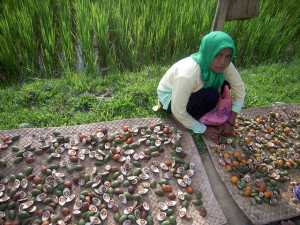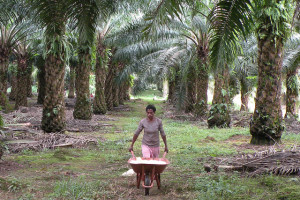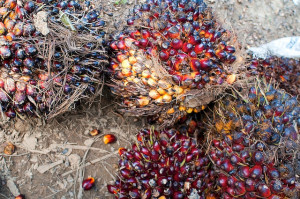Originally published at CIFOR’s Forests News

Oil palm is one of the biggest commodities traded worldwide and a key research theme of the CGIAR Research Program on Forests, Trees and Agroforestry (FTA). Jack Hewson looks at recent outcomes from a study on this lucrative and controversial crop in Indonesia.
Most people want to do the right thing in life. But sometimes doing what’s right can be costly or inconvenient. So additional incentives are needed to encourage good behavior.
Nowhere is this more apparent than in the palm oil industry.
Producing palm oil sustainably requires producers to, among other things, reduce biodiversity loss and deforestation, prevent the exploitation of staff and minimize pollution and GHG emissions. But this often goes above and beyond the laws of the country in which they are operating and is much more costly and complex than business as usual among their competitors.
So, other than contributing to a better environmental future and claiming a few hectares of moral high ground, what else is motivating growers to meet these standards?
“We’ve found that two of the major motivators include, first and foremost, the business risk that producers are exposed to, when associated with unsustainable practices. And secondly, the relationships and alliances that businesses form,” said Sophia Gnych, a scientist at the Center for International Forestry Research (CIFOR) and the lead author of recently published research on the subject.
MAKING INROADS

Civil society groups and consumers have played a key role in increasing the reputational and market risks for companies operating unsustainably.
As a result, standards like the Roundtable on Sustainable Palm Oil (RSPO), which certifies the sustainable practices of growers, have made significant inroads in the industry.
RSPO-certified palm oil accounted for 21 percent of the 13.47 million tons of palm oil produced globally last year – an impressive uptake since the first certified palm oil was brought to market in 2008.
But despite these gains, certification requires actions and includes costs that only some growers can meet. Therefore, certifying the whole supply base may not be feasible.
“Right now, the uptake of certification standards is limited to the larger corporations,” said Gnych, referring to major oil palm producers like Golden Agri Resources and Wilmar.
Companies like these face significant business risks if they are found to be sourcing unsustainable palm oil. They also have the capacity to meet sustainability criteria and still make a profit. However, the same cannot always be said of the smallholders that many of these companies source from.
GETTING TO THE ROOT OF IT

Smallholders are less motivated by reputational risk, as they have no recognizable brand to defend. But their access to mills and the international market matters.
Smallholders, who produce roughly 40 percent of Indonesian palm oil, and are a significant driver of deforestation and other sustainability challenges, are more likely to resist change. Many do not have the knowledge, technical capacity, capital or financial flexibility to upgrade their practices in line with sustainability standards.
But recent commitments by major global palm oil traders to eliminate deforestation from their supply chains threatens to exclude smallholders.
A study conducted in West Kalimantan, Indonesia, showed that smallholders lost up to 70 percent of their potential income due to “plantation costs” and the repayment of credit. In this context, it is understandable that the added costs of sustainable practices — like better monitoring and reporting of standards and training in good agricultural practices — present major obstacles to change.
Adding to these barriers are entrenched attitudes and practices among government and many who manage and staff the industry — from farmers to mill-owners — who may not fully understand sustainability concerns, or what they mean in practice.

The interplay of these factors has generated “a fractured and complex landscape of social and environmental policies, standards and regulations,” said Gnych.
And, perhaps unsurprisingly, the solutions are likely to be similarly complicated.
“I don’t think that there is a one-size-fits-all response to this,” Gnych said, “but currently palm oil producers aren’t even meeting the minimum legal standards.”
Gnych’s research lays out a number of suggestions to improve sustainability in the industry. Among them include enforcement of existing regulations and better land-use planning from government, bringing the sustainability conversation to the local level and delivering high-quality, affordable technical assistance and services to smallholders.
The study also examines the other side of the equation — the demand side — that is all too often ignored.
SUPPLY AND DEMAND
Speaking at the International Conference on Oil Palm and Environment (ICOPE) in Bali in March, Indonesia’s Coordinating Minister for Economic Affairs Darmin Nasution pointed to the demand side as the locus of the problem.
“Some European countries will not hesitate to promote a boycott on non-sustainable palm oil, however, they have yet to be willing to pay a premium for sustainable products,” he said.
“We cannot take the burden alone, the cost of being sustainable is not only the producers’ responsibility, but also the consumers’ responsibility.”
So what to make of the minister’s comments? If consumers seek to be more sustainable, will they be required to shoulder the added costs of palm oil sustainability as well?
“Everyone needs to play their part. I don’t think it’s necessarily about the consumer paying more. It’s about distributing costs fairly along the value chain,” Gnych said.
“Right now, most of the profits are yielded at the retail, manufacturing, refining and trading stages. Motivating greater uptake in this regard will center around streamlining the supply chain and the redistribution of wealth.”
“Basically, it’s about the big guy giving a better deal to the little guy, and acknowledging the true costs of sustainable production.”











